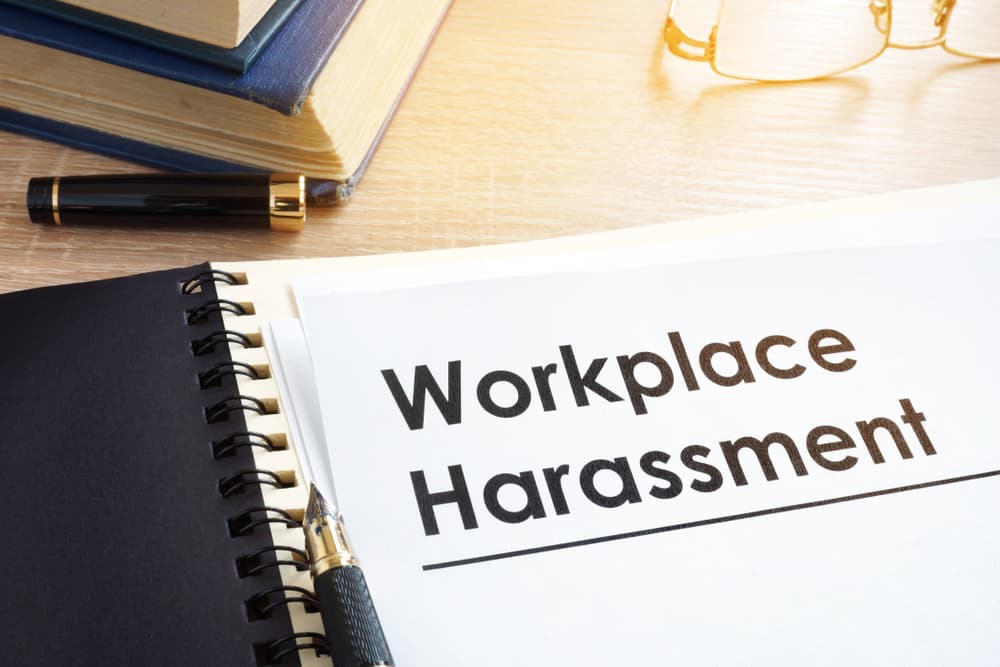Sexual harassment is a pervasive issue in workplaces across various industries, affecting a significant number of workers. This type of harassment can have detrimental effects on employees’ mental health, job satisfaction, and overall well-being.
If you face workplace sexual harassment, seek legal assistance from a sexual harassment lawyer or attorney as soon as possible to protect your rights.
SCHEDULE A FREE CASE EVALUATION
Definition of Sexual Harassment

Sexual harassment in the workplace can take on many forms. However, it typically refers to any unwelcome sexual advances, requests for sexual favors, or other verbal or physical conduct of a sexual nature that creates a hostile or offensive work environment.
It can take different forms, including:
- Unwanted sexual comments or jokes
- Inappropriate touching or physical contact
- Displaying sexually explicit materials
- Sexual coercion or pressure
- Telling sexual rumors or spreading gossip
- Offensive gestures or looks
Many people do not believe sexual harassment will happen to them. However, with the high percentage of reported victims of workplace harassment, chances you might experience this conduct are, unfortunately, high.
The Prevalence of Sexual Harassment
Sexual harassment in the workplace is more common than many people realize. Studies and surveys provide valuable insights into the scope of the problem.
According to a survey by the Equal Employment Opportunity Commission (EEOC), approximately 25 to 85 percent of women reported experiencing some form of sexual harassment at work.
Factors such as varying definitions of sexual harassment, cultural differences, and fear of reporting account for the wide range in this statistic.
Furthermore, studies show that men also experience sexual harassment (about 10 to 45 percent report being subject to sexual harassment), although at a lower rate compared to women.
Keep in mind that these statistics only represent reported cases, and the actual number of workers facing sexual harassment may be much higher. Many victims choose not to report due to fear of retaliation, damage to their reputation, or lack of confidence in the legal system.
Gender Disparities in Sexual Harassment
While both men and women can experience sexual harassment, women are disproportionately affected.
Research consistently shows that women are more likely to be victims of sexual harassment in the workplace compared to men. This gender disparity can be due to various factors, including power dynamics, societal gender norms, and cultural and organizational biases.
The higher prevalence of sexual harassment towards women can have significant consequences for their career advancement. Women may face challenges in seeking promotions, obtaining equal pay, and accessing opportunities for professional growth.
The fear of encountering sexual harassment can also discourage women from pursuing specific career paths or industries where harassment is more prevalent.
Workplace Factors Contributing to Sexual Harassment

Several workplace factors contribute to sexual harassment incidents. Power dynamics play a significant role, with harassers often occupying positions of authority or influence over their victims. A culture that tolerates or promotes disrespectful behavior and harassment can perpetuate a hostile work environment.
The lack of effective policies and reporting mechanisms further exacerbates the problem. Many organizations have inadequate policies or fail to enforce existing ones, leaving victims without recourse or support.
Additionally, a lack of awareness or understanding of the legal and ethical obligations to prevent such misconduct may lead to a reluctance to address sexual harassment issues.
Legal Obligations to Address Sexual Harassment
Employers have legal obligations to prevent and address sexual harassment in the workplace. The U.S. federal law prohibits sexual harassment under Title VII of the Civil Rights Act of 1964.
Employers must maintain a work environment free from sexual harassment, initiate prompt and thorough investigations when complaints occur, and take appropriate corrective action to address the issue.
Failure to comply with these obligations can result in legal consequences for employers, including fines and penalties. Moreover, you can hold employers liable for the actions of their employees, raising the importance of fostering a workplace culture that prioritizes respect and inclusivity.
Psychological Impact of Sexual Harassment
Sexual harassment can have severe psychological consequences for victims. It can lead to anxiety, depression, and post-traumatic stress disorder. Victims may experience declining self-esteem and job satisfaction, leading to decreased productivity and professional growth.
The distress caused by sexual harassment can also spill over into personal life, affecting relationships and overall well-being.
Providing support and resources for victims is vital. Organizations should prioritize creating a safe and supportive environment where employees feel comfortable reporting incidents and seeking help.
Counseling services, employee assistance programs, and awareness campaigns can address the psychological impact of sexual harassment.
Physical Health Effects
The stress of experiencing sexual harassment can take a toll on the victim’s physical health. Physical symptoms such as headaches, gastrointestinal issues, sleep disturbances, and high blood pressure are common among those who have experienced sexual harassment.
Career Implications
Sexual harassment can adversely impact a victim’s professional life. Victims may suffer from decreased job satisfaction, diminished productivity, and disrupted career trajectories. They may even feel compelled to leave their jobs altogether, resulting in financial instability and a loss of opportunities.
Understanding the Reasons Behind Sexual Harassment

To combat sexual harassment effectively, everyone should understand the underlying reasons behind this unacceptable behavior.
Various factors contribute to the occurrence of sexual harassment in the workplace, including:
- Power Imbalance: Sexual harassment often stems from an abuse of power dynamics within organizations. Perpetrators may exploit their positions of authority to engage in inappropriate behavior and exploit vulnerable employees.
- Gender Stereotypes: Prevalent gender stereotypes perpetuate a culture that normalizes and enables sexual harassment. These stereotypes create an environment where victims face blame while harassers face minimal consequences.
- Lack of Awareness and Training: Many organizations fail to provide comprehensive training on sexual harassment prevention and identification. This lack of awareness often leads to a normalization of inappropriate behavior and a failure to address it promptly.
- Organizational Culture: Organizations with a culture that encourages or turns a blind eye to sexual harassment contribute to its prevalence. Creating a culture of respect and zero tolerance for harassment is essential in combating this issue.
- Societal Factors: Societal norms and attitudes towards gender roles and sexuality also play a significant role in the occurrence of sexual harassment. Widespread beliefs that perpetuate gender inequality can contribute to an environment where harassment thrives.
Industries Prone to Sexual Harassment
While sexual harassment can occur in any workplace, certain industries have higher incidences of such behavior. Some of these industries include:
Hospitality and Service Industry
Jobs in the hospitality and service industry, such as hotels, restaurants, and bars, often involve interactions with customers or clients. This customer-facing nature can make employees more vulnerable to sexual harassment.
Healthcare Industry
In the healthcare industry, where the power dynamics between doctors, nurses, and patients are distinct, cases of sexual harassment can occur. Workers in hospitals, clinics, and long-term care facilities may face harassment from patients, colleagues, or superiors.
Education
Educational institutions, including schools, colleges, and universities, are not immune to sexual harassment. Students and staff members alike may become victims of unwanted advances, verbal abuse, or other forms of harassment.
Examples of Workplace Sexual Harassment

Sexual harassment can take various forms and occur in different scenarios. It is imperative to recognize the different manifestations of workplace sexual harassment to address and prevent them effectively. Here are some common examples:
Verbal Harassment
Verbal harassment involves unwanted comments, jokes, or innuendos of a sexual nature. It can create a hostile work environment and cause emotional distress to the victim.
Examples of verbal harassment include:
- Inappropriate comments about a person’s appearance or clothing
- Sexual jokes or innuendos that create an uncomfortable atmosphere
- Lewd or suggestive remarks directed at an individual
Physical Harassment
Physical harassment involves unwanted physical contact or advances of a sexual nature. It can range from inappropriate touching to more severe forms of assault.
Examples of physical harassment include:
- Unwanted touching, groping, or patting
- Forceful hugs or kisses without consent
- Blocking someone’s path or cornering them in an intimidating manner
Non-Physical Harassment
Non-physical harassment refers to actions or behaviors that are not overtly physical but still cause discomfort or harm.
It can include:
- Sending sexually explicit or inappropriate emails, texts, or messages
- Displaying explicit materials or content in the workplace
- Making derogatory or offensive comments about someone’s gender or sexual orientation
Quid Pro Quo Harassment
Quid pro quo harassment occurs when someone with power or authority in the workplace demands sexual favors in exchange for job benefits or advancement. It creates a highly coercive and abusive environment.
Examples of quid pro quo harassment include:
- A supervisor promising a promotion in exchange for a sexual relationship
- Threatening retaliation or job loss if an employee refuses sexual advances
- Conditioning job benefits or opportunities for engaging in sexual activities
Steps to Take if You Face Workplace Sexual Harassment
Experiencing workplace sexual harassment can be incredibly distressing. Here are some vital steps to take if you find yourself in such a situation:
Document the Incidents
Keep a record of all incidents, including dates, times, locations, and the people involved. Document any witnesses who may have observed the harassment. Save memos, letters, emails, or other documentation that might be evidence.
Maintaining a detailed log can provide substantial evidence if you decide to take legal action.
Talk to a Trusted Colleague or Supervisor
Reach out to a trusted colleague or supervisor who can offer support and guidance. Choosing someone who will take your concerns seriously and help you navigate the appropriate channels is important.
Review Workplace Policies
Familiarize yourself with your company’s policies and procedures regarding sexual harassment. Understand the reporting process and the steps to address your complaint.
File a Formal Complaint
If informal measures do not resolve the issue, consider filing a formal complaint with your employer’s human resources department. Provide them with all the relevant details and evidence you have collected.
Consult a Sexual Harassment Lawyer
If your situation remains unresolved or if you face retaliation after reporting the harassment, it may be necessary to consult a sexual harassment lawyer. They can provide legal advice, support, and guidance throughout the process.
Why You Should Consult a Sexual Harassment Lawyer or Attorney

If you have experienced sexual harassment in the workplace, consulting a sexual harassment lawyer or attorney is in your best interest to protect your rights and seek justice.
Here are some reasons why you need legal assistance:
- Experienced Guidance: Sexual harassment lawyers or attorneys have experience in this area of law. They will be with you every step of the process, protecting your rights and providing invaluable support during this challenging time.
- Legal Options: A skilled lawyer or attorney will assess your case and inform you about your available legal options. They will explain the potential outcomes and advise on the best course of action.
- Evidence Collection: Gathering and preserving evidence is crucial in proving your case. A sexual harassment lawyer or attorney can collect and organize evidence such as emails, text messages, witness statements, or any other relevant documentation.
- Negotiation and Settlement: If possible, your lawyer or attorney can negotiate with the opposing party to reach a fair settlement. They will work diligently to secure a resolution that both compensates you for the harm suffered and holds the perpetrator or the organization accountable.
- Litigation Support: In cases where negotiation fails, your sexual harassment lawyer or attorney will provide vigorous representation in court. They will prepare your case for court, present it effectively, and ultimately fight for the justice you deserve.
Seek Legal Assistance Today
Take a stand against sexual harassment and protect your rights by securing representation by an experienced employment attorney. They are dedicated to helping victims of sexual harassment through the often confusing legal process and obtain the justice they deserve.
Remember, you are not alone, and legal support is available to address the traumatic effects of sexual harassment in the workplace. If you have experienced sexual harassment in the workplace, don’t hesitate to take immediate action and seek legal help.